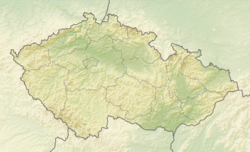Horní Domaslavice
Horní Domaslavice | |
|---|---|
View towards the church | |
| Coordinates: 49°41′44″N 18°27′33″E / 49.69556°N 18.45917°E | |
| Country | |
| Region | Moravian-Silesian |
| District | Frýdek-Místek |
| First mentioned | 1597 |
| Area | |
• Total | 5.07 km2 (1.96 sq mi) |
| Elevation | 320 m (1,050 ft) |
| Population (2024-01-01)[1] | |
• Total | 1,053 |
| • Density | 210/km2 (540/sq mi) |
| Time zone | UTC+1 (CET) |
| • Summer (DST) | UTC+2 (CEST) |
| Postal code | 739 51 |
| Website | www |
Horní Domaslavice (Polish: Domasłowice Górne) is a municipality and village in Frýdek-Místek District in the Moravian-Silesian Region of the Czech Republic. It has about 1,100 inhabitants.
Geography
[edit]Horní Domaslavice is located about 7 kilometres (4 mi) east of Frýdek-Místek, in the historical region of Cieszyn Silesia. It lies in the Moravian-Silesian Foothills. The highest point is at 360 m (1,180 ft) above sea level. The Lučina River flows through the municipality.
History
[edit]The village was first mentioned in a Latin document of Diocese of Wrocław called Liber fundationis episcopatus Vratislaviensis from around 1305 as Domaslawitz utroque. It meant that there were already two villages of that name (utroque meaning "both" in Latin), the other being Dolní Domaslavice.[2]
Politically the village belonged initially to the Duchy of Teschen. In 1327 the duchy became a fee of the Kingdom of Bohemia, which after 1526 became part of the Habsburg monarchy.
The village became a seat of a Catholic parish, mentioned in the register of Peter's Pence payment from 1447 among 50 parishes of Teschen deanery as Domaslowicz.[3]
After the 1540s Protestant Reformation prevailed in the Duchy of Teschen and a local Catholic church was taken over by Lutherans. It was taken from them (as one from around fifty buildings) in the region by a special commission and given back to the Roman Catholic Church on 24 March 1654.[4]
After Revolutions of 1848 in the Austrian Empire a modern municipal division was introduced in the re-established Austrian Silesia. The village as a municipality was subscribed to the political and legal district of Cieszyn. According to the censuses conducted in 1880–1910 the population of the municipality dropped from 798 in 1880 to 789 in 1910 with a majority being native Czech-speakers (between 94.2% and 97.8%) accompanied by a small Polish-speaking minority (at most 29 or 3.7% in 1900) and German-speaking (at most 40 or 5% in 1880). In terms of religion in 1910 majority were Roman Catholics (98.6%), followed by Protestants (10 or 1.3%) and 1 Jew.[5]
After World War I, Polish–Czechoslovak War and the division of Cieszyn Silesia in 1920, the municipality became a part of Czechoslovakia. Following the Munich Agreement, in October 1938 together with the Trans-Olza region it was annexed by Poland, administratively adjoined to Cieszyn County of Silesian Voivodeship.[6] It was then annexed by Nazi Germany at the beginning of World War II. After the war, it was restored to Czechoslovakia.
Demographics
[edit]
|
|
| ||||||||||||||||||||||||||||||||||||||||||||||||||||||
| Source: Censuses[7][8] | ||||||||||||||||||||||||||||||||||||||||||||||||||||||||
Transport
[edit]There are no railways or major roads passing through the municipality.
Sights
[edit]The main landmark of Horní Domaslavice is the Church of Saint James the Great. It was built in the Baroque style in 1740–1745.[9]
References
[edit]- ^ "Population of Municipalities – 1 January 2024". Czech Statistical Office. 2024-05-17.
- ^ Panic, Idzi (2015). Śląsk Cieszyński w średniowieczu (do 1528) [Cieszyn Silesia in Middle Ages (until 1528)] (PDF) (in Polish). Cieszyn: Starostwo Powiatowe w Cieszynie. pp. 297–299. ISBN 978-83-935147-8-6.
- ^ "Registrum denarii sancti Petri in archidiaconatu Opoliensi sub anno domini MCCCCXLVII per dominum Nicolaum Wolff decretorum doctorem, archidiaconum Opoliensem, ex commissione reverendi in Christo patris ac domini Conradi episcopi Wratislaviensis, sedis apostolice collectoris, collecti". Zeitschrift des Vereins für Geschichte und Alterthum Schlesiens (in German). 27. Breslau: H. Markgraf: 361–372. 1893. Retrieved 21 July 2014.
- ^ Broda, Jan (1992). "Materiały do dziejów Kościoła ewangelickiego w Księstwie Cieszyńskim i Państwie Pszczyńskim w XVI i XVII wieku". Z historii Kościoła ewangelickiego na Śląsku Cieszyńskim (in Polish). Katowice: Dom Wydawniczy i Księgarski „Didache“. pp. 259–260. ISBN 83-85572-00-7.
- ^ Piątkowski, Kazimierz (1918). Stosunki narodowościowe w Księstwie Cieszyńskiem (in Polish). Cieszyn: Macierz Szkolna Księstwa Cieszyńskiego. pp. 263, 281.
- ^ "Ustawa z dnia 27 października 1938 r. o podziale administracyjnym i tymczasowej organizacji administracji na obszarze Ziem Odzyskanych Śląska Cieszyńskiego". Dziennik Ustaw Śląskich (in Polish). 18/1938, poz. 35. Katowice. 31 October 1938. Retrieved 1 July 2014.
- ^ "Historický lexikon obcí České republiky 1869–2011" (in Czech). Czech Statistical Office. 2015-12-21.
- ^ "Population Census 2021: Population by sex". Public Database. Czech Statistical Office. 2021-03-27.
- ^ "Kostel sv. Jakuba Staršího" (in Czech). National Heritage Institute. Retrieved 2022-03-18.




